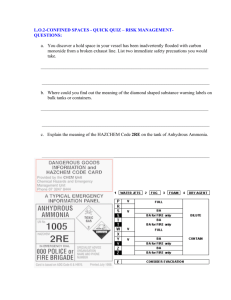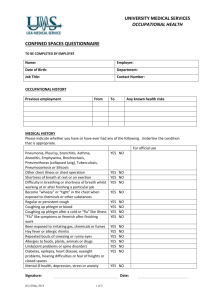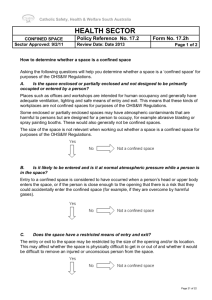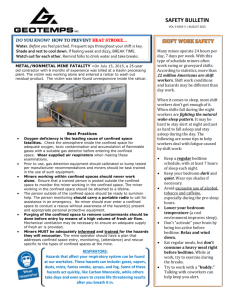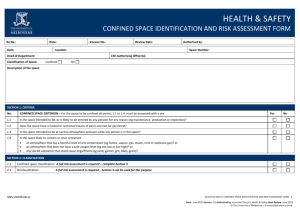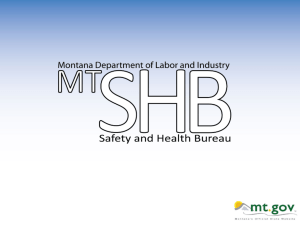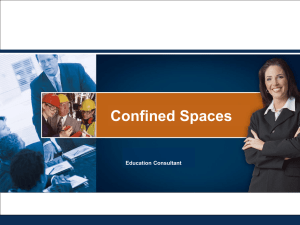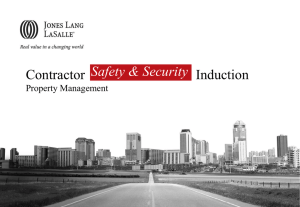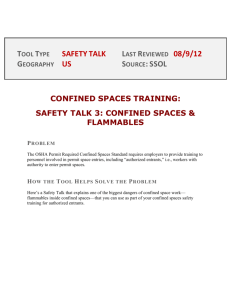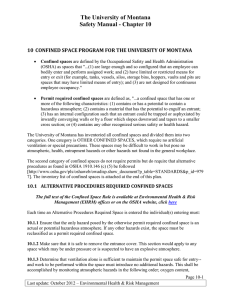Plant and Equipment Maintenance
advertisement
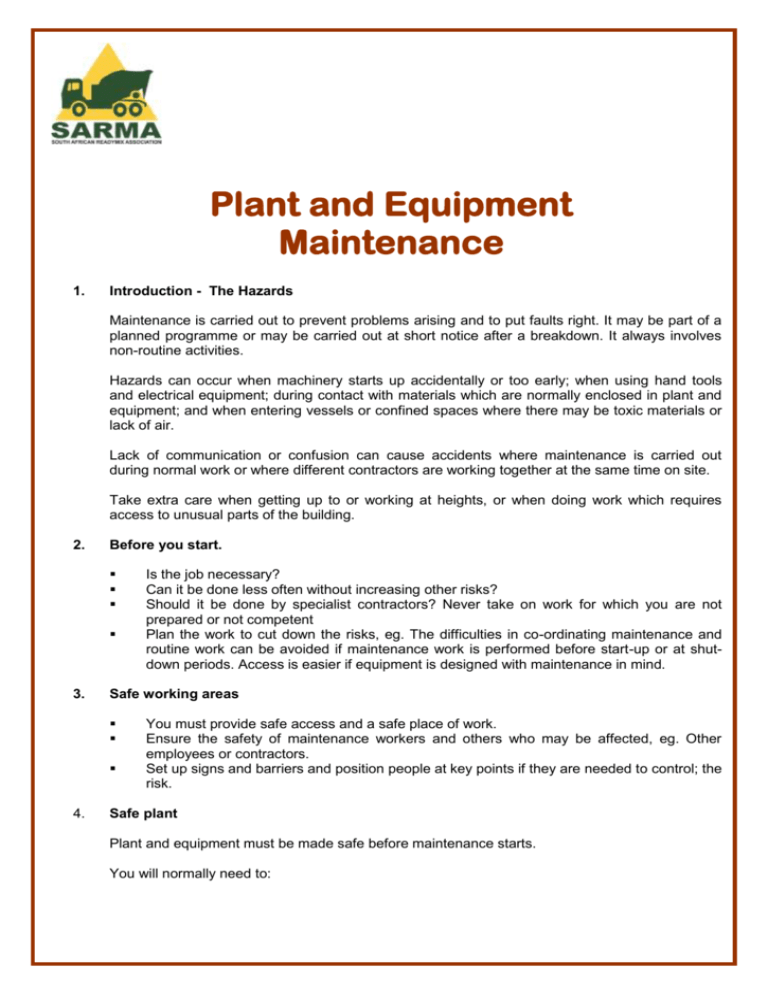
Plant and Equipment Maintenance 1. Introduction - The Hazards Maintenance is carried out to prevent problems arising and to put faults right. It may be part of a planned programme or may be carried out at short notice after a breakdown. It always involves non-routine activities. Hazards can occur when machinery starts up accidentally or too early; when using hand tools and electrical equipment; during contact with materials which are normally enclosed in plant and equipment; and when entering vessels or confined spaces where there may be toxic materials or lack of air. Lack of communication or confusion can cause accidents where maintenance is carried out during normal work or where different contractors are working together at the same time on site. Take extra care when getting up to or working at heights, or when doing work which requires access to unusual parts of the building. 2. Before you start. 3. Safe working areas 4. Is the job necessary? Can it be done less often without increasing other risks? Should it be done by specialist contractors? Never take on work for which you are not prepared or not competent Plan the work to cut down the risks, eg. The difficulties in co-ordinating maintenance and routine work can be avoided if maintenance work is performed before start-up or at shutdown periods. Access is easier if equipment is designed with maintenance in mind. You must provide safe access and a safe place of work. Ensure the safety of maintenance workers and others who may be affected, eg. Other employees or contractors. Set up signs and barriers and position people at key points if they are needed to control; the risk. Safe plant Plant and equipment must be made safe before maintenance starts. You will normally need to: Plant and Equipment Maintenance 5. Isolate electrical and other power supplies. Most maintenance should be carried out with the power of. If the work is near uninsulated overhead electrical conductors, eg. close to overhead travelling cranes, cut the power of first; lock off machines if there is a chance the power could be switched back on; Isolate plant and pipelines containing pressured fluid, gas, steam or hazardous material. Lock off isolating valves; support parts of plant which could fall; ensure moving plant is stopped; allow components which operate at high temperatures time to cool; place mobile plant in neutral gear, apply the brake and chock the wheels; Safely clean out vessels containing flammable solids, gases or dusts and check them before hot work is carried out to prevent explosions. You may need specialist help and advice to do this safely. Avoid entering tanks and vessels where possible as this carries a very high risk. If required, get specialist help to ensure adequate precautions are taken; Clean and check vessels containing toxic materials before work starts. Confined spaces A number of people are killed and seriously injured yearly while working in confined spaces. Asphyxiation and toxic fumes are the two most common causes of death, but others include drowning I free-flowing solids, eg grain silos, and fire and explosions. Two or more people are often involved in these incidents. One person is overwhelmed and then others attempt to rescue them without being adequately prepared. What is a confined space? Some confined spaces are fairly easy to identify, eg closed tanks, vessels and sewers. Others are less obvious but may be equally dangerous, eg open-topped tanks and vats, closed and unventilated rooms and silos. Confined spaces exits in all sectors of industry, so it is not possible ton provide a complete list. You should identify where hazards arise in your workplace and take precautions. Deal with confined spaces Identify all confined spaces. Do the work from outside where possible Appropriate precautions Isolate the vessel to stop dust, fumes or hazardous substances getting in. Clean up to ensure fumes do not develop from residue etc while the work is being done. Test the atmosphere to check that it is free from toxic or flammable vapours and that there is enough fresh air. Make sure there is enough ventilation to ensure adequate supply of fresh air. Use non-sparking tools. Do not use petrol or diesel equipment inside the confined space. Make sure rescue equipment and enough trained personnel are ready at hand for rescue and resuscitation. Use safe lighting (eg low voltage). Plant and Equipment Maintenance 6. Hand tools You must ensure hand tools are properly maintained, eg 7. Hammers – avoid split, broken or loose shafts and worn or chipped heads. Make sure heads are properly secured to the shafts. Files – should have a proper handle. Never use them as levers. Chisels – the cutting edge should be sharpened to the correct angle. Do not allow the head to spread to a mushroom shape – grind off the sides regularly. Screwdrivers – should never be used as a chisel, and hammers should never be used on them. Split handles are dangerous. Spanners – avoid splayed jaws. Scrap any which show signs of slipping. Have enough spanners of the right size. Do not improvise by using pipes etc as extension handles. Vehicle repairs Make sure brakes are applied and wheels chocked. Always start and run engines with the brakes on and in neutral gear. Support vehicles on both jacks and axle stands (never rely on jacks alone). Always prop raised bodies. Beware of explosion risk when draining and repairing fuel tanks, and from battery gases – do not drain petrol tanks over a pit. Tare care not to short-circuit batteries. Use a tyre cage when inflating commercial tyres, particularly those with split rim wheels – explosions do happen. Avoid breathing asbestos dust from brake and clutch lining pads – the best approach is to use asbestos-free linings. Wear protective clothing when handling battery acid. Be aware of the risk from mineral oil contamination on hands and other parts of the body, eg for those changing engine oils, Good hygiene is essential including making sure overalls are cleaned regularly and that you wash your hands before going to the toilet to avoid transferring oil. www.aspasa.co.za P O Box 1983 Ruimsig HU UH email: office@aspasa.co.za Tel: 011 791 3327 August 2012
